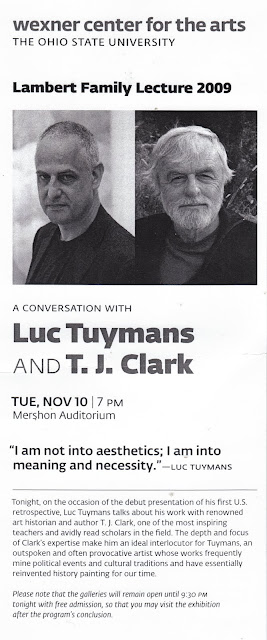MP3 of the talk here.
Around 1:23:00 I ask Tuymans the following:
"Most of the work in this show deals with pernicious policies enacted by ruling classes, for instance Belgium's colonialism or, in America, the policies of the Bush administration. But because of the way your work circulates in the world, the people who benefit from these policies are the only ones who can own your work. Is this bothersome for you or do you view it as poetic justice?"
A review I wrote for class of the talk after "the jump."
Thankfully the Wexner Center decided to move this talk from the Film and Video Theater to the Mershon Auditorium. It’s a wonder why they thought the 300 person theater would be able to hold the audience – art students and teachers, who are conscripted to attend, would account for at least 100 seats. Not that the Mershon was packed, but the large lower level did end up being comfortably filled.
Sherri Geldin introduced the event with a cringe-worthy preface that compared Tuymans to Manet and used turns of phrase like “the diseased individual’s body and the diseased body politic.” Managed to mention the OSU / Michigan football rivalry. Sidenote: Geldin was a student of Clark at UCLA.
Tuymans and Clark were interesting characters to spend time with. Tuymans is sort of a seductive bastard – love to hate or hate to love type. Furiously spinning off politically incorrect non-sequitors (that’s why the Japanese love taking photos – WTF?, Americans are like Germans in reverse – OK?) between overly grand statements (Photography is proof!) and some valid insights into his process. Unlike the majority of contemporary artists who stand behind their work and make nary a peep, Tuymans is more than happy to explicate on his work – even the pieces Clark prodded him on that are 23 years old.
This is important (and sort of necessary) since Tuymans work is really more short story illustration than painting. It has an unhealthy dependence on narrative, turning the following trick over and over:
1. Your initial experience of the painting formally.
2. Your befuddlement over the inscrutable content – which usually appears innocuous.
3. Someone or something (the title, rumors, docent, catalog) giving you the appropriate key to unlock meaning – where the image is appropriated from, what the German title means, etc.
4. You reconciling your initial, innocent view of the work with the deleterious reality it actually represents.
Without the explanations and backstories his work would be some interesting formal turns, murky palette and mysterious content – not much more. Correctly, Tuymans had this to say about the role of explanation: “The work doesn’t say it all, a painting can’t talk – it’s mute.”
Clark – who I was more interested in hearing from – had the presence of an overly genial grandpa. At turns, he lavished Tuymans with praise, read overly poetic interpretations of Tuymans’ paintings and spent long stretches of time spitting out equivications and caveats before saying anything approaching critical. His was a difficult position though – really more of a simple facilitator than embodying any role based on his own work. His kindly demeanor allowed for much comedy contrasted with Tuymans’ inveterate cursing and constant putdowns. I liked Clark’s discussion of print and photo capitalism’s ability to create imagined communities. I wanted that to go on.
Other highlights: Tuymans’ cufflinks, Tuymans’ annoyance at his microphone, Tuymans’ distaste for France, Clark’s discomfort, Clark’s revelatory sounds (Ah! Yes, I see!).
The questions and questioners, though occasionally awkward (ZAS), were much better than the Q & A sessions at similar talks. But still they stuck to formal and “What are we supposed to think” questions.







1 comment:
the word fuck was used like little sprinkles of salt placed upon a moving slug, thats for sure.
Post a Comment